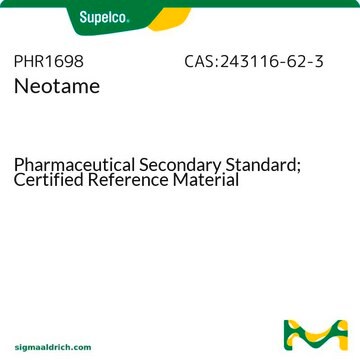59304
2-Propanol
≥99.5% (GC), for molecular biology, BioUltra
Synonym(s):
sec-Propyl alcohol, IPA, Isopropanol, Isopropyl alcohol
About This Item
Recommended Products
product name
2-Propanol, BioUltra, for molecular biology, ≥99.5% (GC)
grade
for molecular biology
Quality Level
vapor density
2.1 (vs air)
vapor pressure
33 mmHg ( 20 °C)
44 mmHg ( 25 °C)
product line
BioUltra
assay
≥99.5% (GC)
form
liquid
autoignition temp.
750 °F
expl. lim.
2.0-12.7 %, 93 °C
technique(s)
DNA extraction: suitable
RNA extraction: suitable
impurities
DNases, none detected
RNases, none detected
insoluble matter, passes filter test
phosphatases, none detected
proteases, none detected
evapn. residue
≤0.001%
color
colorless
refractive index
n20/D 1.377 (lit.)
n20/D 1.378
bp
82 °C (lit.)
mp
−89.5 °C (lit.)
solubility
water: soluble (completely)
density
0.785 g/mL at 25 °C (lit.)
cation traces
Al: ≤0.5 mg/kg
Ba: ≤0.1 mg/kg
Bi: ≤0.1 mg/kg
Ca: ≤0.5 mg/kg
Cd: ≤0.05 mg/kg
Co: ≤0.02 mg/kg
Cr: ≤0.02 mg/kg
Cu: ≤0.02 mg/kg
Fe: ≤0.1 mg/kg
K: ≤0.5 mg/kg
Li: ≤0.1 mg/kg
Mg: ≤0.1 mg/kg
Mn: ≤0.02 mg/kg
Mo: ≤0.1 mg/kg
Na: ≤0.5 mg/kg
Ni: ≤0.02 mg/kg
Pb: ≤0.1 mg/kg
Sr: ≤0.1 mg/kg
Zn: ≤0.1 mg/kg
SMILES string
CC(C)O
λ
neat
UV absorption
λ: 260 nm Amax: 0.02
λ: 280 nm Amax: 0.01
suitability
suitable for molecular biology
InChI
1S/C3H8O/c1-3(2)4/h3-4H,1-2H3
InChI key
KFZMGEQAYNKOFK-UHFFFAOYSA-N
Looking for similar products? Visit Product Comparison Guide
General description
Application
- to precipitate genomic DNA extracted from flies
- to precipitate genomic DNA extracted from xenograft primary tumors and organs
- to immunoprecipitate 5-bromo-2-deoxyuridine (BrdU)
Biochem/physiol Actions
Features and Benefits
- Suitable as a reagent for Biochemical and Molecular Biology Research
- BioUltra grade, meets strict purity standards through rigorous testing
- Free from DNase, NICKase, RNase, and Protease
- Tested to confirm low levels of heavy metal contamination, ensuring suitability for various applications
Other Notes
comparable product
signalword
Danger
hcodes
Hazard Classifications
Eye Irrit. 2 - Flam. Liq. 2 - STOT SE 3
target_organs
Central nervous system
Storage Class
3 - Flammable liquids
wgk_germany
WGK 1
flash_point_f
53.6 °F - closed cup
flash_point_c
12.0 °C - closed cup
ppe
Eyeshields, Faceshields, Gloves, type ABEK (EN14387) respirator filter
Certificates of Analysis (COA)
Search for Certificates of Analysis (COA) by entering the products Lot/Batch Number. Lot and Batch Numbers can be found on a product’s label following the words ‘Lot’ or ‘Batch’.
Already Own This Product?
Find documentation for the products that you have recently purchased in the Document Library.
Customers Also Viewed
Our team of scientists has experience in all areas of research including Life Science, Material Science, Chemical Synthesis, Chromatography, Analytical and many others.
Contact Technical Service





